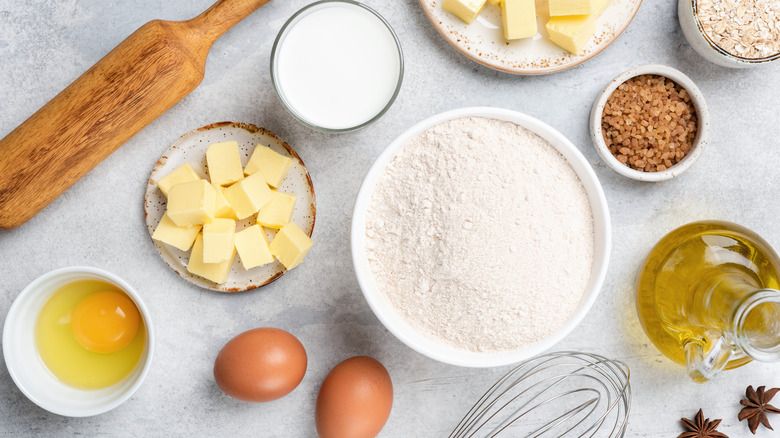Never Break One Butter Rule When It Comes To Baking
As any home cook can tell you, baking is all about the rules. While you may be able to substitute ingredients here and there, certain parts of recipes simply can't be changed. Butter shouldn't be the only fat used in cookies, cakes, and other baked goods — margarine and other choices can be fantastic — but most recipes need a certain amount of fat that "butter spreads" simply can't provide.
When you're at the store, avoid butter or margarine products labeled as "low-fat" or "reduced-fat." Also, avoid vague terms like "buttery spread," as these undoubtedly indicate substitutes for full-fat products. The reason to pass up on these comes down to science: Butter and margarine contain an 80% fat to 20% water ratio, which is what many baking recipes require. Besides adding flavor, fat is a major contributor to the texture of baked goods because it wraps around flour particles, preventing them from absorbing too much water. When flour does absorb large amounts of moisture, it starts developing excess gluten, making the end product tough, dense, and chewy rather than tender and airy.
Meanwhile, low-fat spreads contain a lot more water and an inadequate amount of fat, so they simply can't fulfill the same functions. They add a less rich flavor, an undesirable texture, and basically waste all the time you've spent baking. However, good substitutions for butter and margarine do exist; you just have to account for small differences.
Two substitutions for butter or margarine
If you want to make a 1:1 substitution for butter or margarine, look for ingredients that consist of 100% fat (like lard, shortening, or oil). These make the substitution simple, posing less of a risk of sabotaging your baking recipe. However, any substitution you make in baking requires some amount of experimentation to get perfect results.
Oils such as olive, avocado, or coconut are 100% fat and a great hack to make an incredibly moist cake. For most batters and doughs, 1:1 substitutions work well, but you might need additional water to get the right consistency. For cakes, you can replace a few tablespoons of oil with a liquid to get closer to that fat and water balance, while cookies may need even less oil and more water to form a dough that's not dry nor greasy. And when using olive oil, it's best to grab something milder in flavor like "light" varieties, so your baked good doesn't taste overwhelmingly of olives.
Greek yogurt has its own do's and don'ts in the kitchen, but it's a great baking substitute for butter, even though it has a little more moisture. It contains plenty of fat and adds a nice tang to your recipes. However, if you are swapping more than one cup of butter for yogurt, you may need to add more flour to your bakes. Try an extra ¼ cup of flour to compensate for the added water.


